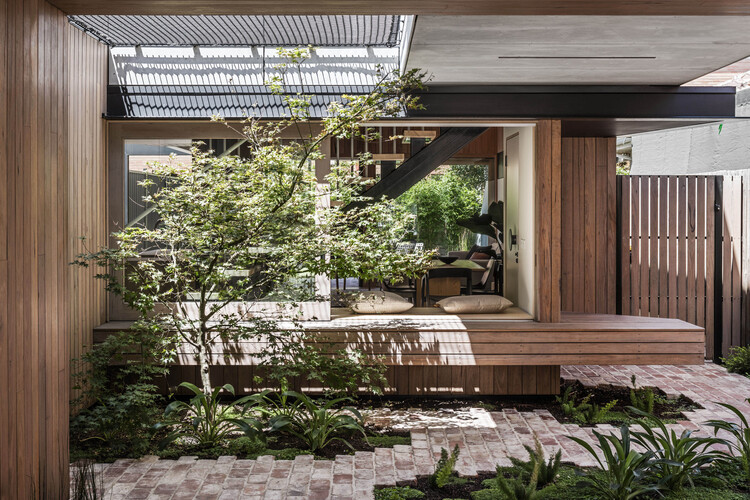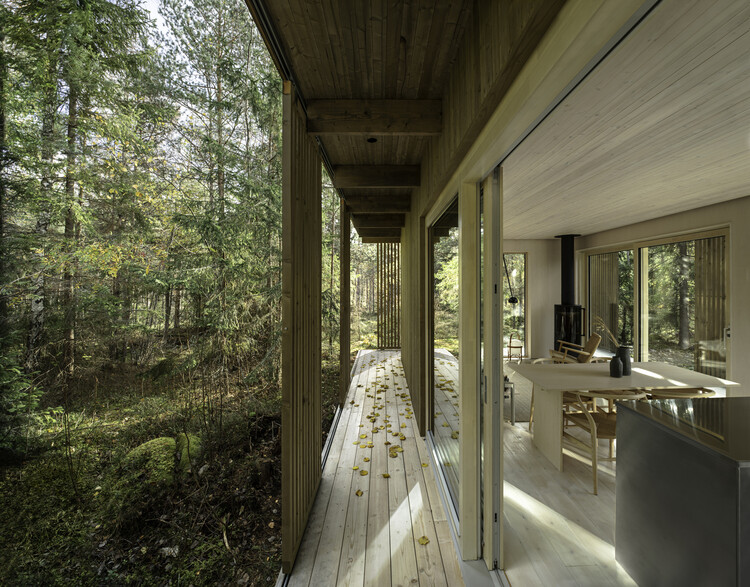
Humans are hard-wired to respond positively to nature; the crackling sound of fire, the smell of fresh rain on soil, the healing characteristics of plants and the color green, being in proximity to animals, etc. That, along with today’s critical environmental conditions and rapid urbanization, shifted architects' focus towards eco-conscious projects to bring people closer to nature. Architects explored numerous approaches: rammed earth structures, recycled materials and furnishing, designing around the site's sun orientation... The practice was so driven by green architecture that the lines became blurred between what is truly sustainable and ecological and what is "greenwashed". But what proved to bring about the most innate biological connection with nature was biophilia, and "bringing the outdoors in" through design.
By definition, biophilic design promotes wellbeing by incorporating elements that establish a coherent relationship between nature, human biology, and the building physically, visually, and emotionally. This includes using natural materials, incorporating greenery, an abundance of natural light, and making room for natural ventilation, to name a few. The successful application of biophilic design principals stimulates a wide spectrum of physical, mental and behavioral benefits. Physical benefits include improved fitness, lower blood pressure, and fewer illness symptoms. Mental benefits include motivation, productivity, creativity, and a decrease in stress and anxiety. Behavioral and cognitive changes include improved coping skills, enhanced attention span, and increase in social interaction.

For decades, scientists, researchers, architects, and designers have been collaboratively exploring how to utilize the aspects of nature that most impact our relationship with the built environment. Many theorists organize biophilic design principles under three categories: nature in the space, nature of the space, and natural analogues, all of which determine a physical, visual, and emotional connection to the natural world. This framework, however, goes beyond materials, light, and ventilation, all of which are significant contributors to biophilic spaces. Effective biophilic design lets earth be the architecture itself, or at least a big part of it. And what seems to be often overlooked is that it is also locally-appropriate design, meaning that the architecture should not just blend with nature, it should blend with its nature - the specific surroundings of the project itself.
Take a look at how architects prioritized human wellbeing, and reinforced biophilia and the relationship between nature, human biology, and the built environment through 21 projects from our database.
Material Selection
In light of the environmental crises and heightened focus on wellbeing, architects resorted to environmentally-conscious architecture with the aim of triggering a shift in the current practice, beginning with what the projects are built with. For thousands of decades, Earth and its resources have been used to construct monumental structures that have withstood the test of time. But it was recent studies that proved how using such materials creates positive cognitive and physiological responses as well. And with that, architects went back to extracting materials from the local terrain through minimal processing, reflecting the local geology to establish authenticity and a sense of place, as well as promoting sustainability-driven architecture.
The Wendy House / Earthscape Studio

TECLA Technology and Clay 3D Printed House / Mario Cucinella Architects

Sunyata Eco Hotel / Design Kacheri
Nature within the Space
One of the most prominent and common ways architects have integrated biophilic elements in their interior designs is through greenery, water, and fire elements. The benefits of plantscaping, or incorporating plants in interiors, are boundless. In terms of biophilic design however, plants are not chosen arbitrarily, but are chosen based on the climate conditions, geographic characteristics, and availability to ensure that the interior is authentically one with its surroundings. Several studies also have shown that seeing, hearing, or touching water reduces stress, increases tranquility and concentration, and lowers heart rate, prompting architects to install water walls, aquariums, miniature ponds, fountains, and streams.
Wyndham Clubhouse / MIA Design Studio

Greenary Residence / Carlo Ratti Associati

Nha Khoa Nu Cuoi Viet Dental Clinic / BHA studio

Lighting
Nowadays, especially after the recent changes to working dynamics, time is mostly spent inside rooms that are illuminated with a mix of artificial and natural lighting. However, all the design possibilities and flexibilities that artificial light has offered has not yet replaced the way the human body responds to natural light, nor how much it needs it to function properly. A human’s circadian rhythm, or the 24-hour biological cycle, is primarily influenced by light reception, followed by temperature and other stimuli. Being heavily exposed to artificial light, especially at night, alters the body’s biological clock, and affects productivity, appetite, and energy levels. As a result, architects prioritized natural lighting and ensured that the characteristics of artificial light are almost identical to it. Biophilic characteristics of light also encompass the variables of light and shadow, and how their intensities and the way they complement each other in a space affect the visual comfort of users.
Workshop Ricostruzione - The New Dance School / Mario Cucinella Architects


St-Charles Dental Clinic / Studio Jean Verville architectes

Airflow
When it comes to air circulation and thermal comfort, biophilia can be characterized as complementing the qualities and variable changes in temperature and humidity. Ideally, the overall air quality should provide comfort and vitality, as well as give users the possibility of adjusting the thermal conditions, whether manually or automatically, based on their needs and preferences.
The Vibes Office / Infinitive Architecture


Urban Farming Office / VTN Architects

Thorncrown Chapel / E. Fay Jones

Physical and Visual Access to Nature
To further establish the connection to nature, architects have built projects with interiors in direct connection to the surrounding landscape, both physically and visually. This blurred boundary between the architecture and the site it sits on limits the impression of “man-made” and promotes a sense of openness and freedom, allowing architecture and nature to become one.
Six Square House / Young Projects

Gimme Shelter / gimme shelter solutions

TreeVilla at Forest Hills / Architecture BRIO


Biomimicry and Organic Forms
Along with natural interventions and construction materials, organic/biomorphic forms and textures also serve as strong references to patterns found in nature. Curves, for instance, have already been dominating interior design trends during the past couple of years, but it actually dates back centuries to when architects found inspiration in nature from the asymmetrical lines of flowers and animals. And since the human psyche prefers curved visual objects because they signal lack of threat, the architectural expression of organic forms in interior design was translated into furniture, lighting, textile, partitions, and wall motifs.
Zolaism Café / B.L.U.E. Architecture Studio

Kindergarten in Guastalla / Mario Cucinella Architects


Spatial Organization and Layout
In terms of interior architecture and circulation, biophilia is the adoption of the spatial patterns found in nature and interpreting them as the configuration of an interior space. The purpose behind these patterns is to prioritize the wellbeing of users, especially if it’s an unfamiliar place for them. In scenarios of the latter, the human mind automatically shifts into survival mode and looks for a place that offers safety and protection “from the unknown”, similar to how animals react in open landscapes. These spatial patterns can be seen architecturally as refuge zones, open-yet-protected areas, and in-between transitional spaces, all of which reduce stress levels and irritation, and provoke a sense of protection, creativity, and exploration.
Edgars Creek House / Breathe Architecture

Once Upon a Time in the Perche House / Java Architecture

Second Home Hollywood Office / Selgascano


Find more biophilic interiors in this My ArchDaily folder created by the author.
This article is part of an ArchDaily series that explores features of interior architecture, from our own database of projects. Every month, we will highlight how architects and designers are utilizing new elements, new characteristics and new signatures in interior spaces around the world. As always, at ArchDaily, we highly appreciate the input of our readers. If you think we should mention specific ideas, please submit your suggestions.
This article is part of the ArchDaily Topics: Circular Economy. Every month we explore a topic in-depth through articles, interviews, news, and architecture projects. We invite you to learn more about our ArchDaily Topics. And, as always, at ArchDaily we welcome the contributions of our readers; if you want to submit an article or project, contact us.
Editor's Note: This article was originally published on February 03, 2023.

























